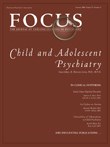Early-Onset Bipolar Disorder
Abstract
Despite dramatic increases in the rate at which bipolar disorder is being diagnosed in children and adolescents, there remain several outstanding questions regarding definitional issues, valid assessment procedures, effective treatment approaches, and the degree of continuity between early-onset bipolar disorder phenotypes and adult forms of the illness. In the present article, the authors provide a historical context for the current interest in early-onset bipolar spectrum conditions, followed by a discussion of phenomenology, definitional issues, prevalence rates, common comorbidities, differential diagnosis, course of illness, assessment, and treatment. The value of maintaining a multidisciplinary approach is emphasized, as well as the importance of going beyond standardized diagnostic criteria to understand the current and developmental contexts in which behaviors are being expressed.



